World Geography STAAR Review – Flashcards
Unlock all answers in this set
Unlock answersquestion
absolute location
answer
The location of a place represented by latitude and longitude.
question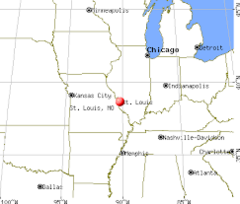
relative location

answer
The location of a place in comparison to another location.
question
bar scale
answer
A line resembling a ruler used to measure distance.
question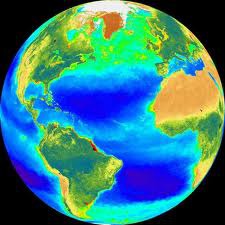
biosphere

answer
The regions of the earth that contain living organisms.
question
cape

answer
A point of land that extends into a sea or lake.
question
cartogram
answer
A type of map that has a scale based on some statistic other than land area.
question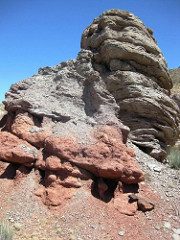
chemical weathering

answer
This involves the change in the composition of rocks that results in weathering.
question
choropleth map
answer
A map that uses differences in shading or coloring to indicate statistical ranges.
question
conformal map
answer
A map projection that preserves correct shape
question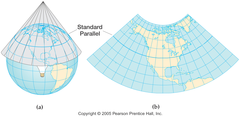
conic projection

answer
A projection that shows lines of longitude as radiating straight lines and lines of latitude as curved lines
question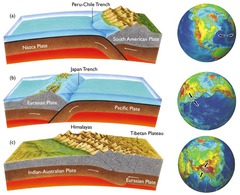
convergent boundaries

answer
Area where two tectonic plates move toward one another and collide
question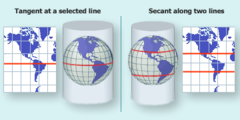
cylindrical projection

answer
Projection that shows latitude and longitude as straight lines at right angles to each other
question
delta
answer
A triangular area of sediment deposited at the mouth of a river.
question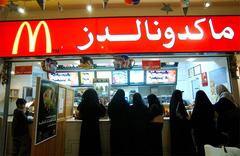
spatial diffusion

answer
The process by which cultural elements spread from one area to another
question
distortion

answer
The alteration of the shape of landmasses that occurs when map projections are created
question
divergent plate boundaries
answer
Places where plates move away from each other.
question
equal area projection
answer
Type of projection that preserves correct relative size
question
erosion
answer
The process by which the surface of the earth is worn away by the action of water, glaciers, or wind
question
fault
answer
A break in the surface of the earth that occurs when tectonic plates move past each other
question
flood plain
answer
A nearly flat area along the course of a stream or river that is naturally subject to flooding
question
formal region
answer
A region that has some common characteristic (Also called a uniform region.)
question
functional region
answer
A region that is tied together by movement or interaction
question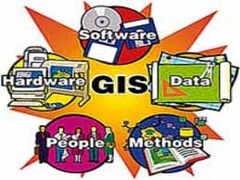
Geographic Information System (GIS)

answer
Powerful software programs that layer geographic information.
question
Global Positioning System (GPS)

answer
Satellites that provide precise location using signals
question
Great Circle Route
answer
The shortest distance between any two places on the surface of the earth.
question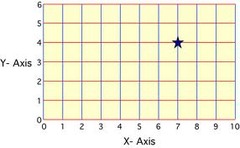
grid system

answer
lines of latitude and longitude
question
International Date Line
answer
An imaginary line following approximately the 180th degree of longitude. (Regions to the east are counted as one day earlier than regions to the west.
question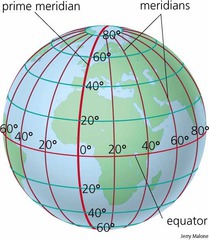
meridian

answer
Another name for lines of longitude.
question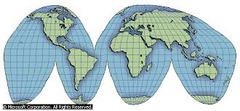
interrupted projection

answer
Projection that maintains correct shape of landmasses by dividing oceans
question
landsat
answer
A set of satellites that use sensors to gather data for images of the Earth's land surface
question
large scale map
answer
Maps that cover smaller areas with greater detail
question
latitude
answer
Imaginary lines that run east and west and measure distance north and south of the equator.
question
longitude
answer
Imaginary lines that run north and south and measure distance east and west of the equator.
question
map projection

answer
The process of depicting the round earth on a flat surface
question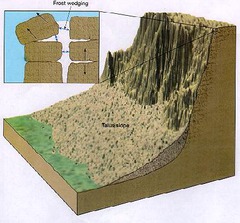
mechanical weathering

answer
The process of breaking rock into smaller and smaller pieces without changing its chemical structure
question
Mercator cylindrical projection
answer
Map projection that greatly enlarges landmasses in the northern latitudes.
question
meridian

answer
Another term for lines of longitude
question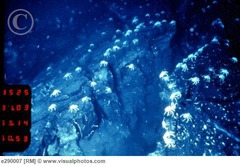
mid-oceanic ridge

answer
An underwater mountain range formed when tectonic plates diverge and magma rises.
question
parallel

answer
Another name for lines of latitude
question
perceptual region
answer
Also called a vernacular region. These are a reflection of people's mental maps and as such are difficult to map.
question
pin dot map
answer
A thematic map that uses points to represent an individual occurrence; Dr. Snow's map and population maps are examples.
question
plane/polar/azimuthal projection
answer
The projection created by placing an imaginary flat surface directly above or below a globe
question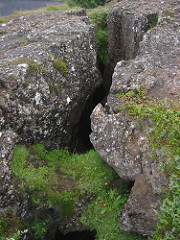
plate tectonics

answer
A theory that the earth's lithosphere is composed of several rigid pieces that float on the mantle. The resulting interaction of the plates creates landforms.
question
Prime Meridian
answer
Zero degrees longitude.
question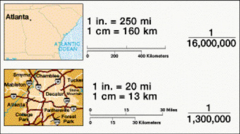
ratio scale

answer
A map scale that shows the relationship of a unit on a map to the same unit on the surface of the earth
question
remote sensing
answer
The use of instruments mounted on satellites or in planes to produce images or "scenes" of the Earth's surface.
question
representative fraction
answer
Map scale that represents the ratio as a fraction.
question
rift valley
answer
Landform that results when two land plates separate.
question
Ring of Fire
answer
Region of tectonic activity surrounding the Pacific Ocean
question
Robinson/Compromise Projection
answer
Projections that contain elements of cylindrical, conic, and plane projections
question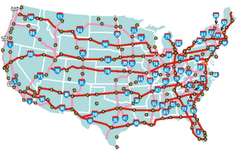
small scale map

answer
A map that shows a larger area without much detail
question
subduction
answer
Process that occurs when one plate slides under another plate
question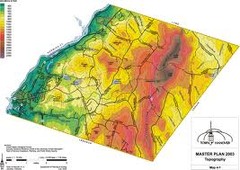
topography

answer
the surface features of a place or region including mountains, hills, valleys, streams, and lakes
question
isoline map
answer
Maps that have lines connecting points of equal value (such as elevation)
question
transform boundary
answer
Plate boundaries that are sliding past each other resulting in a fault
question
volcano

answer
a break in the earth's crust through which molten lava and gases erupt
question
Antarctic Circle
answer
The imaginary line that circles the South Pole and receives 24 hours of darkness on the June solstice
question
Arctic Circle
answer
Imaginary line located at 66 1/2 degrees north; Points north of this line receive 24 hours of sunlight on the June solstice.
question
Autumnal Equinox
answer
Occurs on or about September 22 when all parts of the Earth receive 12 hours of daylight and 12 hours of night.
question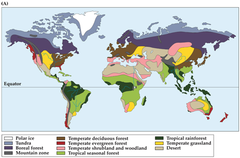
biome

answer
A large area on the Earth's surface that is defined by the types of animals and plants that live there
question
climate

answer
Generally prevailing weather conditions of a region
question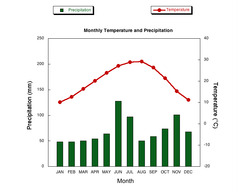
climograph

answer
A graphical representation of monthly average temperature and precipitation at a certain location
question
condensation
answer
The process of water vapor being turned to water as air temperature cools.
question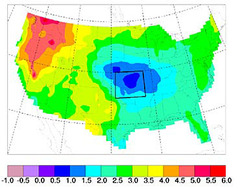
continentality

answer
The tendency of inland areas to experience more temperature variation than areas close to water
question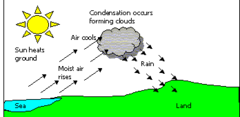
convection

answer
The upward movement of heat in masses of air; A body of air which is warmer will rise because if is less heavy
question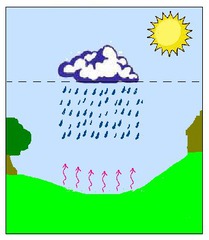
convectional precipitation

answer
The formation of precipitation due to surface heating of the air at the ground surface
question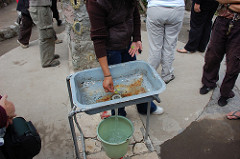
Coriolis Effect

answer
The force produced by the turning of the Earth in space, which tends to bend the path of moving objects to the right in the northern hemisphere and to the left in the southern hemisphere.
question
El Nino
answer
A warm ocean current that flows along the coast of Peru every seven to fourteen years
question
Equator
answer
0 degrees latitude
question
frontal precipitation
answer
Type of precipitation that occurs when a warm and cold air mass come together
question
high pressure zones
answer
Found at 30 degrees north and south (where arid and semiarid climates prevail).
question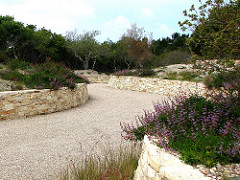
highland climate

answer
Cool to cold climates found in mountains and on high plateaus. The climate changes as altitude changes.
question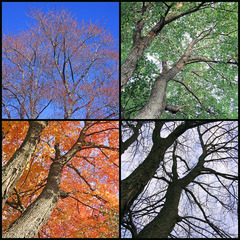
humid continental climate

answer
Climate found in the northeastern part of the United States--typified by large seasonal temperature differences with warm to hot summers.
question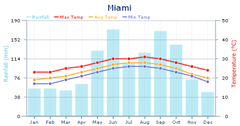
humid subtropical climate

answer
Climate zone characterized by hot, humid summers and generally mild to cool winters.
question
La Nina
answer
The cooling of waters off the coast of South America.
question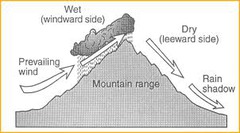
windward

answer
The direction from which the wind blows--the wetter side of a mountain because of orographic precipitation
question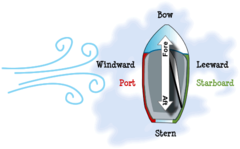
leeward

answer
The side of a mountain away from the wind--it is drier because it is in the rain shadow.
question
low latitudes
answer
The areas of the earth from 0 degrees to 30 degrees latitude
question
low pressure zones
answer
Created when warm air rises (as occurs in equatorial regions).
question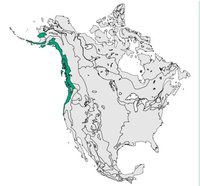
marine west coast climate

answer
climate zone influenced by oceans, found on west coast of continents in upper middle latitudes. Characterized by mild temperatures with winters that are foggy, cloudy, and rainy.
question
Mediterranean climate
answer
climate found across Southern Europe; it features warm and sunny summer days, mild evenings, and cooler, rainy winters
question
middle latitudes
answer
Latitude zone found between 30 degrees and 60 degrees on either side of the equator
question
orographic precipitation
answer
Type of precipitation that occurs when winds force warm, moist air up the side of a mountain
question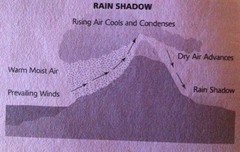
rain shadow

answer
The dry area opposite the windward side of a mountain;
question
revolution

answer
One trip of the earth around the sun that occurs in 365 days
question
rotation
answer
One turn of the earth on its axis (responsible for day and night)
question
savanna
answer
Vegetation zone with a rolling grassland scattered with shrubs and isolated trees--found between tropical rain forests and desert biomes
question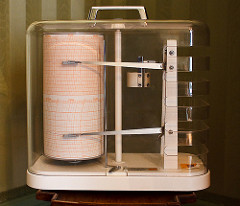
seismograph

answer
Instrument used to measure earthquake activity
question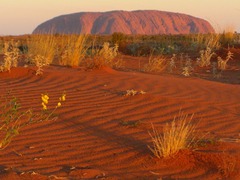
semiarid

answer
Climate zone that transitions between arid and tropical climates.
question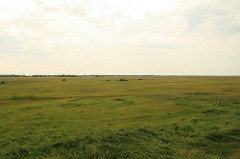
steppe

answer
Temperate grassland of Eurasia consisting of level, generally treeless plains
question
storm surge
answer
The rise of water beyond what would be expected by the normal movement due to tides
question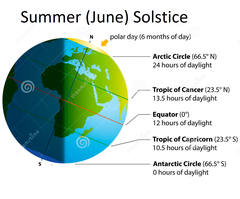
June solstice

answer
Occurs when the direct rays of the sun fall along the Tropic of Cancer.
question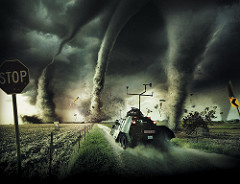
tornado alley

answer
Area within the United States where tornadoes are most frequent
question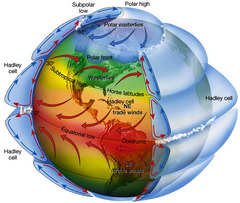
trade winds

answer
A wind blowing steadily toward the equator from the northeast in the northern hemisphere or the southeast in the southern hemisphere
question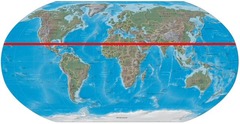
Tropic of Cancer

answer
The circle of latitude on the Earth that marks the northernmost point where the direct rays of the sun fall
question
Tropic of Capricorn
answer
Line of latitude that marks the farthest point south at which the sun can be seen directly overhead
question
tropical wet
answer
Humid climate zones found in low pressure zones along the equator
question
tropical wet and dry
answer
climate zone that is hot all year with rainy and dry seasons; transition between humid tropical and arid climates
question
tsunami

answer
A long high sea wave caused by an underwater earthquake
question
weather
answer
Atmospheric conditions at a given time and place
question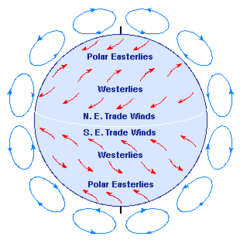
westerlies

answer
Prevailing winds in the middle latitudes that blow from west to east.
question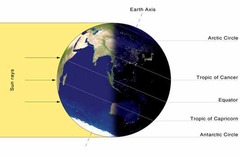
winter solstice

answer
When the direct rays of the sun fall along the Tropic of Capricorn. The longest day of the year in the Southern Hemisphere
question
baby boom generation
answer
The age cohorts that reflect the increased birth rate that occurred after World War II
question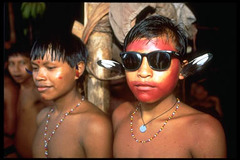
acculturation

answer
changes to the social patterns and culture traits of one group as it comes into contact with a more dominant culture
question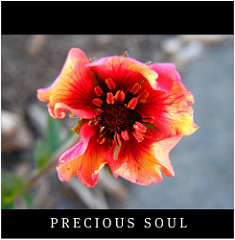
animism

answer
belief that objects, such as plants and stones, or natural events, like thunderstorms and earthquakes, have a spirit and conscious life
question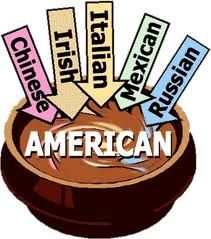
assimilation

answer
process by which people of one culture merge into and become part of another culture
question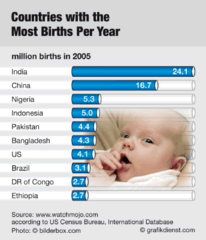
birth rate

answer
the number of babies born per 1,000 people during one year
question
Buddhism
answer
religion that originated in northern India and spread to East Asia where it is still strong
question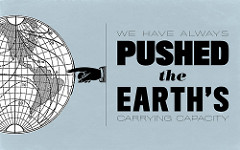
carrying capacity

answer
The maximum population of any species that an environment can sustain indefinitely
question
creole
answer
The blended language that evolves from a pidgin language
question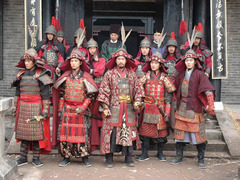
clan

answer
Family groups within a tribe
question
culture
answer
The total of knowledge, attitudes, and behaviors shared by and passed on by members of a group
question
culture hearth
answer
The place of origin of a major culture
question
culture realm
answer
The broadest regional classification; Latin America and Sub-Saharan Africa are examples
question
culture trait
answer
A single cultural practice, such as eating with chopsticks or shaking hands
question
Demographic Transition Model
answer
The model of population growth that shows the relationship between population growth and levels of development
question
demography
answer
The statistical study of human populations
question
emigration
answer
The act of leaving one's country or region to settle in another
question
factors of fertility
answer
...economic development, educating females, and reducing the infant mortality rate are all examples of...
question
fertility rate
answer
The average number of children a woman of childbearing years will have in her lifetime at the current rate for her country.
question
2.1
answer
Replacement TFR
question
immigration
answer
The act of coming to live in a country
question
Indo-European
answer
Language family of half the world's population, including speakers of Germanic and Romance languages
question
innovation
answer
Taking existing cultural elements and creating something new to meet a need
question
j-curve
answer
Line that represents exponential growth, as that occurring in human populations during most of the last century.
question
lingua franca
answer
A second language used for communication between communities.
question
megacities
answer
A metropolitan area with a total population of more than 10 million people
question
pidgin
answer
A simplified blended language used in the marketplace.
question
popular culture
answer
Cultural traits such as dress, diet and music that identify and are part of today's changeable, urban-based, media-influenced western societies
question
folk culture
answer
Culture traditionally practiced by a small, homogeneous, rural group living in relative isolation from other groups.
question
population pyramid

answer
A model used in population geography to show the age and sex distribution of a particular population
question
push factors
answer
negative conditions and perceptions that induce people to leave their adobe and migrate to a new location
question
pull factors
answer
a factor that draws or attracts people to another location
question
rate of natural increase
answer
birth rate minus the death rate, suggesting the annual rate of population growth without considering net migration
question
S-curve
answer
Leveling off of an exponential, J-shaped curve when population growth rates begin to slow
question
Sikhism
answer
The doctrines of a monotheistic religion founded in the Punjab area of northern India in the 16th century by Guru Nanak and combining elements of Hinduism and Islam
question
standard language
answer
The form of a language used for official government business, education, and mass communications.
question
toponymy
answer
The study of the origins and meaning of place-names
question
transculturation
answer
Cultural borrowing that occurs when different cultures of approximately equal complexity and technological level come into close contact
question
tribe
answer
Any system of social organization made up of villages, bands, or other groups with a common ancestry, language, culture, and name
question
ethnic religions
answer
Religions that are identified with a particular group that does not seek new converts
question
universalizing religions
answer
Religions that actively seek converts because they view themselves as offering belief systems of universal appropriateness and appeal
question
Judaism
answer
The first major monotheistic religion. It is based on a sense of ethnic identity, and its adherents tend to form tight-knit communities wherever they live.
question
Hinduism
answer
A religion and philosophy developed in ancient India, characterized by a belief in reincarnation and a supreme being who takes many forms.
question
Christianity
answer
a monotheistic system of beliefs and practices based on the Old Testament and the teachings of Jesus as embodied in the New Testament and emphasizing the role of Jesus as savior
question
Islam

answer
A religion based on the teachings of the prophet Mohammed which stresses belief in one god (Allah), Paradise and Hell, and a body of law written in the Koran. Followers are called Muslims.
question
Buddhism
answer
a world religion or philosophy based on the teaching of Siddhartha Gautama and holding that a state of enlightenment can be attained by suppressing worldly desire
question
Shinto
answer
A Japanese religion whose followers believe that all things in the natural world are filled with divine spirits
question
artificial boundaries
answer
a political boundary that does not follow physical features
question
barter system
answer
an economic system in which goods or services are traded without the exchange of money
question
capitalism
answer
an economic system based on the profit motive, private property and free enterprise
question
centrifugal forces
answer
forces that divide a state - internal religious, political, economic, linguistic, or ethnic differences
question
centripetal forces
answer
forces that tend to unite or bind a country together
question
command economy
answer
a system in which the central government makes all economic decisions
question
commercial agriculture
answer
Type of economic activity in which crops and animals are produced for the market; Usually characterized by use of advanced technology and large farms
question
communism

answer
a political system characterized by a centrally planned economy with all economic and political power resting in the hands of the central government
question
Concentric Zone Model
answer
A structural model of the American central city that suggests the existence of five concentric land-use rings arranged around a common center.
question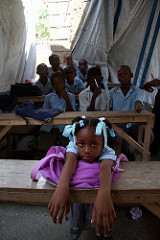
cycle of poverty

answer
Term for the self-reinforcing challenges make it difficult for the poorest countries in the world to develop economically.
question
demand economy
answer
production of goods and services is determined by decisions made in the marketplace
question
free market economy
answer
Capitalism, private ownership law of supply and demand
question
hamlet
answer
A small settlement (smaller than a village) that provides a few goods and services to those living nearby
question
hinterland
answer
Surrounding area served by an urban center. That center is the focus of goods and services produced for its hinterland and it is the dominant urban influence as well.
question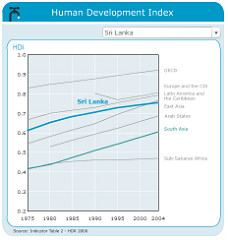
Human Development Index

answer
Measure used by the United Nations to calculate development using three indicators: life expectancy, education, and income
question
infrastructure
answer
the basic support systems needed to keep an economy going, including power, communications, transportation, water, sanitation, and education systems
question
megalopolis
answer
a region in which several large cities and surrounding areas grow together
question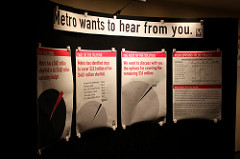
metropolitan area

answer
a functional region that includes a city and its surrounding suburbs and exurbs that are economically linked
question
multiple nuclei model
answer
A representation of urban structure based on the idea that the functional areas (land use) of cities develop around various points rather than just one in the Central Business District
question
nation
answer
a tightly knit group of people with bonds of language, ethnicity, religion, and other shared cultural attributes
question
nation-state
answer
A country and a group of people that share a common culture and identity (Japan or Poland are examples.)
question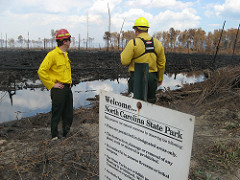
natural boundaries

answer
Boundaries that follow a physical feature
question
per capita GDP
answer
The total value of all goods and services produced in an economy in a given year divided by the population.
question
per capita GNP
answer
divides the total market value of all goods and services produced by the population of the country
question
primary economic activities
answer
Economic activities that involve the extraction of natural resources
question
primate city
answer
the largest city in a country, disproportionately larger than any others in the urban hierarchy.(ie: Mexico City, London, Paris, Seoul)
question
quaternary economic activity
answer
Economic activities that involve the collection, processing, and manipulation of information and capital (finance, administration, insurance, legal services)
question
secondary economic activity
answer
economic activities concerned with the processing of raw materials such as manufacturing, construction, and power generation
question
sector model
answer
A model or urban land use that places the central business district in the middle with wedge-shaped sectors radiating outwards from the center along transportation corridors.
question
socialism
answer
a social and political philosophy based on the belief that democratic means should be used to evenly distribute wealth throughout a society
question
state
answer
The same thing as a country
question
stateless nation
answer
An ethnic group that does not have its own country (Palestinians, Kurds, Roma)
question
subsistence agriculture
answer
Agriculture designed primarily to provide food for direct consumption by the farmer and the farmer's family
question
tertiary economic activities
answer
The economic sector that provides services to other sectors of the economy
question
theocracy
answer
government run by religious leaders
question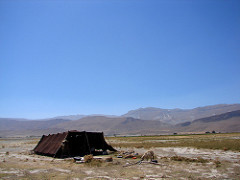
traditional economy

answer
economic system that relies on habit, custom, or ritual to decide questions of production and consumption of goods and services
question
urban hierarchy
answer
a ranking of settlements according to their size and economic functions
question
zone in transition
answer
area of mixed commercial and residential land uses surrounding the CBD; mixture of growth, change, and decline
question
air conditioning
answer
innovation that made it possible for the southern part of the United States to grow economically during the last half of the 20th century
question
al Qaeda
answer
the terrorist group, led by Osama bin Laden, which was responsible for planning and carrying out several terrorist attacks against the United States - most notably the 9/11 attacks
question
Colombian Exchange
answer
The exchange of plants, animals, diseases, and technologies between the Americas and the rest of the world following Columbus's voyages
question
continental divide
answer
mountain ridge that separates river systems flowing toward opposite sides of a continent
question
wheat

answer
The crop that is grown predominantly on the high plains.
question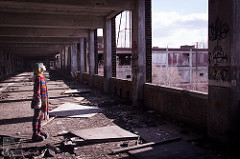
deindustrialization

answer
Process by which companies move manufacturing jobs to other regions with heaper labor leaving an area that must adjust to the loss of jobs
question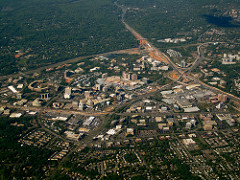
Edge City

answer
A large node of office and retail activities on the outskirts of an urban area; A suburb with its own employment base
question
fall line
answer
a boundary in the eastern United States where the higher land of the Piedmont drops to the lower Atlantic coastal plain, marked by waterfalls and rapids
question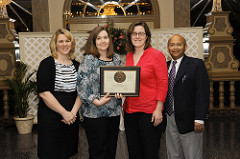
federal system

answer
a government that divides the powers of government between the national government and state or provincial governments
question
First Nations
answer
The name taken by indigenous people in Canada to strengthen the fact that they are distinct ethnicities and therefore should have the right to govern their own territories.
question
free enterprise

answer
The freedom of private businesses to operate competitively for profit with minimal government regulation
question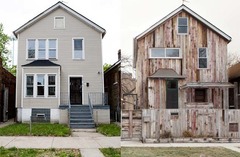
gentrification

answer
the restoration of run-down urban areas by the middle class (resulting in the displacement of lower-income people)
question
gerrymandering
answer
Process of redrawing legislative boundaries for the purpose of benefiting the party in power
question
Grand Banks
answer
The rich fishing area in the Atlantic Ocean near Newfoundland
question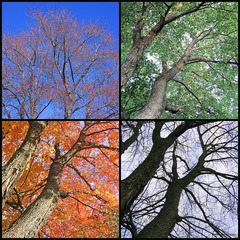
humid continental

answer
Climate zone with four distinct seasons, found in Middle/Upper East coasts and the interior of large landmasses
question
negative correlation
answer
the relationship between two variables in which one variable increases as the other variable decreases
question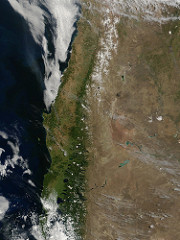
orographic effect

answer
the precipitation that occurs when moist air rises up the sides of a mountain. as the air rises, it cools down and releases most of its moisture as rain or snow
question
parliamentary system
answer
A system of government in which the legislature selects the prime minister or president.
question
piedmont
answer
the plateau between the coastal plain and the Appalachian Mountains: parts of Virginia and North and South Carolina and Georgia and Alabama
question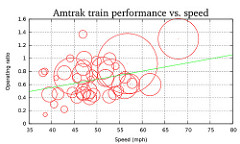
positive correlation

answer
A correlation where as one variable increases, the other also increases, or as one decreases so does the other. Both variables move in the same direction.
question
postindustrial economy
answer
an economic phase in which manufacturing no longer plays a dominant role
question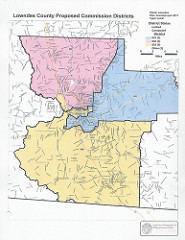
reapportionment

answer
the process of reallocating seats in the House of Representatives every 10 years on the basis of the census
question
representative democracy
answer
Government in which the people elect those who govern and pass laws; also called a republic.
question
rust belt
answer
The manufacturing region in the United States that is experiencing a period of decline as many manufacturing firms are relocated to countries that have cheaper labor and fewer environmental regulations
question
smart growth
answer
legislation and regulations to limit suburban sprawl and preserve farmland.
question
St. Lawrence Seaway

answer
A system of rivers, locks and canals that connect the Great Lakes to the Atlantic Ocean
question
suburbanization
answer
the process of population movement from within towns and cities to the fringes of the metropolitan area
question
locks

answer
in a canal, an enclosure with gates at each end used in raising or lowering boats as they pass from level to level
question
sustainable communities
answer
a community where residents can live and work in harmony with the environment.
question
census

answer
A periodic and official count of a country's population; In the United States this occurs in every year ending in a 0.
question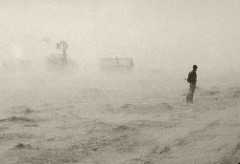
The Dust Bowl

answer
A series of major sandstorms that buried houses, destroyed farmland and killed livestock in the Great Plains in the 1930's
question
The Great Migration
answer
The migration of thousands of African-Americans from the South to the North; African Americans were looking to escape the problems of racism in the South and felt they could seek out better jobs and an overall better life in the North.
question
The Sunbelt
answer
area from Florida to California were the warmer climate, lower taxes, and economic opportunities which attracted many (after the development of air conditioning)
question
urban sprawl
answer
the unplanned and uncontrolled growth of cities into surrounding areas
question
altiplano
answer
The high plateau of the Andes found in Bolivia, Peru, and Argentina.
question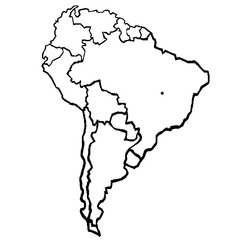
Brasilia

answer
Capital city of Brazil--moved to this more central location from Rio de Janiero in 1960.
question
calypso
answer
A style of music that began in Trinidad and combines musical elements from Africa, Spain, and the Caribbean
question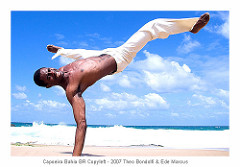
capoeria

answer
A martial art and dance that developed in Brazil from African traditions
question
Carnival
answer
Colorful feast day in Brazil--occurs just before Lent. (Our equivalent is Mardi Gras.)
question
caudillo
answer
A Latin American military dictator or political boss
question
Central America
answer
The countries located between Mexico and South America make up this culture region.
question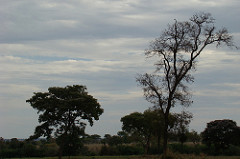
cerrado

answer
Savanna area found in the interior of Brazil; The government is encouraging people to move there for the purpose of developing the land.
question
conservative
answer
On the political spectrum--a person who will work within the system to maintain the status quo
question
criollo
answer
In the colonial era, a person of Spanish blood born in the New World
question
dirty wars
answer
Term applied to the use of military force against a section of its own population--marked by the use of kidnapping and torture.
question
ethanol
answer
Biofuel widely used in Brazil. (In Brazil it is sugarcane-based.)
question
favelas
answer
Self-constructed settlements located on the outskirts of Brazilian cities.
question
forward capital
answer
A capital city that is located in a geographically or demographically peripheral location for economic or strategic reasons. (Brasilia, Islamabad, Yamoussoukro.)
question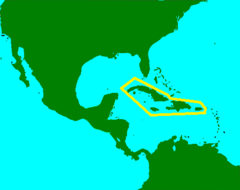
Greater Antilles

answer
The larger islands of the Caribbean--Cuba, Jamaica, Hispaniola, and Puerto Rico
question
Guiana Highlands
answer
Highland area located in the northeast section of South America.
question
Humboldt Current
answer
A cold ocean current that flows north along the coasts of Chile and Peru
question
Inca
answer
Ancient empire located in the Andes Mountains.
question
Machu Picchu

answer
Sacred space for the Inca Indians
question
junta
answer
A government run by generals after a military takeover.
question
left
answer
Side of the political spectrum that favors a change
question
liberal
answer
On the political spectrum--a person who will work within the system to bring change
question
llanos
answer
Grassy, treeless plains found in Colombia and Venezuela--used for livestock grazing and farming.
question
maquiladora
answer
Export processing (assembly) plants located close to the U.S.-Mexican border.
question
MERCOSUR
answer
Free trade organization that includes Argentina, Brazil, Paraguay, and Uruguay
question
mestizo
answer
A person of mixed Europeans and Native American heritage
question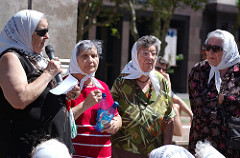
Mothers of the Plaza de Mayo

answer
Organization of bereaved Argentine women whose children "disappeared" during the dirty wars of the military dictatorship.
question
mulatto

answer
A person of mixed African, European, and Native American heritage
question
NAFTA
answer
Agreement to tear down trade barriers among Canada, the United States, and Mexico
question
oligarchy
answer
A government run by a few persons or a small group.
question
pampas
answer
Grasslands of rich soil found in Argentina and Uruguay. The main products are cattle and wheat grain
question
PAN
answer
Political party that came to power in Mexico in 2000 after many decades of control by PRI
question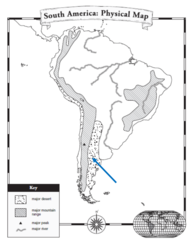
Patagonia

answer
Dry plateau region found in southern Argentina.
question
peninsulare
answer
In the colonial era, a person born in Spain and residing in the New World
question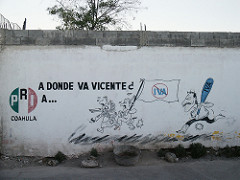
PRI

answer
Political party that controlled Mexico for much of the 20th Century
question
radical
answer
On the political spectrum, a person who would resort to violence to bring change
question
reactionary
answer
On the political spectrum--a person who would resort to violence to maintain the status quo or return to earlier times
question
reggae
answer
A style of music that developed in Jamaica in the late 1960s and is rooted in African, Caribbean, and American music--often dealing with social problems and religion.
question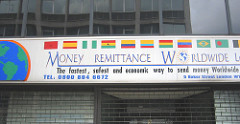
remittances

answer
Money sent home by a foreign worker to his or her home country.
question
right
answer
Side of the political spectrum that wants to stay the same or go back to the way things used to be.
question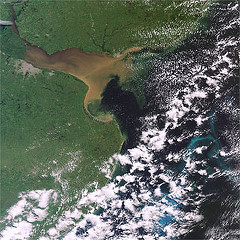
Rio de la Plata

answer
Estuary found where the Parana and Uruguay rivers meet the Atlantic Ocean.
question
estuary
answer
A partly enclosed coastal body of water where freshwater from rivers and streams meets and mixes with salt water from the ocean. (Chesapeake Bay, the Rio de la Plata)
question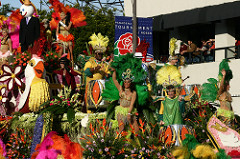
samba

answer
Brazilian dance with African influences; Carnival is a competition of rival dance schools.
question
Tenoctitlan
answer
Capital of ancient Aztec empire--where Mexico City is located today.
question
Caribbean
answer
Where in Latin America would you find the steel drums being played.
question
Hollow Core
answer
Dry interior region of northern Mexico.
question
Southern Cone
answer
Most developed region of Latin America.
question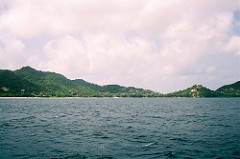
West Indies

answer
Region made up of The Greater Antilles, The Lesser Antilles, and the Bahamas.
question
Treaty of Tordesillas
answer
1494 agreement that divided New World lands between Spain and Portugal.
question
vertical climate zones
answer
As elevation increases in the Andes Mountains, climate and vegetation zones change. Agricultural products vary by elevation.
question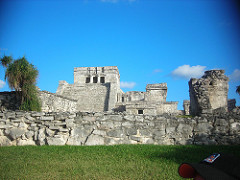
Mayan

answer
Ancient civilization centered on the Yucatan Peninsula.
question
Greater Serbia
answer
term for the state that Serb nationalists wanted to establish when they were all united
question
Iceland
answer
Known as the "Land if Fire and Ice" because glaciers and volcanoes exist side by side



